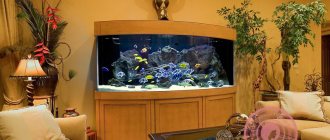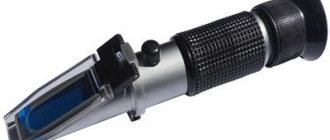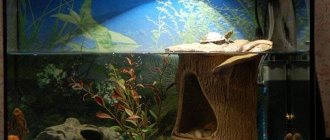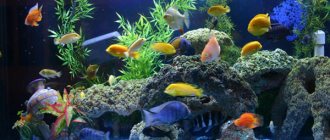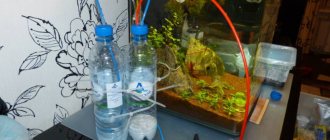Share this article:
A home pond is an entertaining piece of furniture, the appearance of which can constantly change at the owner’s sole discretion. Aquariums are decorated in different ways - some will love underwater castles, while others are meticulous about mowing the lawn every week. There are some aquarists who like to bring the pond closer to its most natural form, where various debris at the bottom serves as part of the interior. A similar design can be created easily and for free.
Is it possible to place an aquarium next to the TV?
The presence of a large amount of water in the room increases the humidity of the air, and certain evaporations come from it. It is not recommended to place a vessel with water close to equipment for the following reasons:
- water evaporation (even if the tank has a lid) enters the equipment and oxidation of parts occurs, which contributes to breakdowns;
- sea inhabitants are negatively affected by radiation and electromagnetic pulses emanating from the screen - their lifespan is reduced, the chance of illness and high mortality increases;
- aesthetically, the screen and the aquarium do not go well together - they distract from each other;
- High humidity is undesirable in a room where electronic devices are present.
Reference! But in general, this question depends on the characteristics of a particular TV, aquarium and the taste preferences of the owners.
Advantages and disadvantages
A 100-liter aquarium allows you to accommodate many different types of inhabitants, since the large volume and the presence of several full layers are sufficient. Moreover, fish, snails, and a variety of plants can be perfectly combined in one tank.
A relative disadvantage of the container is its bulkiness - you will have to allocate a fairly large space in the apartment in order not only to beautifully place the object, but also to provide free access to it.
Choosing an aquarium
The very first thing to start with is choosing a suitable room where the fish will live. A large one is ideal. It should be quite spacious and of course well lit.
Then we move on to choosing the aquarium itself. Of course, it should harmonize well with the room and its size. Size matters a lot. Choosing an aquarium that is too small will limit your ability to achieve benefits. Choosing an aquarium that is too large for a room will bring a wide range of desires into life, and even worse, unnecessary fuss in life. The ideal solution is a medium-sized aquarium and, most importantly, it should be to your liking.
How to properly set up an aquarium at home so that fish and plants feel good?
Beginner aquarists often worry about whether it is possible to place an aquarium in a cool or hot place, in a draft or in a stuffy room...
Artificial light and heating compensate for any unfavorable environmental conditions!
The only rule is that the aquarium should not be placed where there is direct sunlight for more than an hour a day . The sunlight causes algae to multiply rapidly - the walls turn green, and the water “blooms”. Also, some types of fish do not tolerate excessively high temperatures (although not all!), so you should either not place the aquarium in rooms where it is too hot in summer, or select only tropical fish that adapt well to high water temperatures.
What is a dry aquarium?
A dry aquarium in the floor or wall is a niche that is covered with a sheet of glass. For an aquarium, the floor is provided with a very durable coating called triplex, which can withstand heavy loads. Triplex is three layers of impact-resistant glass, bonded using a special technology with a polymer film. This multi-layer design is what makes the material able to withstand weights of up to several hundred kilograms.
Another distinctive feature of three-layer glass that makes it suitable for use in residential areas is its similarity to automotive glass. If you try to break the triplex, it will not crack, but will only become covered with a network of cracks. The thickness of the glass is selected depending on the design and purpose.
The next element of a dry aquarium is its filling, which complements the entire structure with an aesthetic component. Most often, this type of design is selected, similar to a real seascape. This is not mandatory; the design is selected based on your own taste and the overall design of the room. To decorate a dry aquarium, fine sea sand, pebbles and stones, artificial plants, various collages and microlandscape elements are used.
When selecting a composition, it is necessary to take non-perishable materials. If you want to use natural material, then you must first dry it well and apply a special coating to its surface, which will preserve its appearance and prevent the material from decomposing.
How does tea affect fish?
The use of tea helps restore tissue in fish after cuts or minor wounds on the body. It is also effective in the treatment of ichthyophthyriosis , especially if the disease is accompanied by damage to epithelial tissues. Even if the parasites are destroyed with special medications, wounds will still remain on the body of the sick fish. If these wounds are not treated, the fish may develop sepsis. To prevent all this from happening, aquarists use tea to heal the resulting wounds.
How does tea affect fish?
Tea has tonic qualities, so it can be used periodically for preventive purposes or to relieve fish from severe stress. Tea is also used after treatment to mitigate the negative effects of taking medications.
Note! Tea is beneficial not only for fish, but also for aquarium plants . They love a slightly acidic environment, so they take from tea all the necessary components for active growth .
Hexamitosis, or hole disease
Fin rot in aquarium fish
Why do fish die in an aquarium?
White small worms on the glass of an aquarium
Good
We start an aquarium not only out of love for animals and plants, but with their help we strive to create a corner of beauty and tranquility in our home or office. Sometimes this is the main goal. It is known that watching fish and plants is not only interesting, but also helps to relax and unwind.
Of course, all this is in the case when the inhabitants of the aquarium are healthy, the artificial reservoir itself is beautifully designed, and it is convenient for us to observe it. This means that, having decided to start an aquarium, you need to think about not only its appearance and what creatures will inhabit it, but also where and how it will be placed.
You can place an aquarium in any room - in the living room, office, bedroom, hallway, and even the kitchen. The main requirement is that it should not be placed in direct sunlight. Moreover, it is advisable to install it in the darkest place in the room.
Fish need bright light only during spawning and vitamin deficiency, so it is better to install special lighting. The rest of the time, excess light will only cause harm, since with strong lighting, microscopic green algae begin to multiply in the aquarium water. They cover the glass, the plants turn out to be “dressed” with green shoots, and the water begins to bloom.
Bright sunlight is also not a faithful and reliable “neighbor” for fish that are sensitive to overheating. It can negatively affect their health and lead to their death. Another unpleasant thing is that during the day an aquarium standing in the sun warms up well, but at night, especially in the early morning, the water temperature drops by ten degrees.
Even unpretentious fish will not be able to tolerate such a sharp temperature change. For this reason, aquariums should not be placed on windowsills or near windows.
The advantageous place for a vessel with fish will be the eastern side of the apartment. It should be remembered that the aquarium must be placed at a considerable distance from the window, so that the light falls on its front and side parts - against the wall perpendicular or opposite to the window.
The worst option would be a room with a window facing south; in this case, the aquarium should be placed no closer than 2-2.5 meters from it. If your window faces north, then place the aquarium next to it; if it faces west, place it a little further.
The main assistant in lighting an aquarium is fluorescent lamps. Such lighting is easier to regulate and adapt to aquatic inhabitants. and bright sunlight can lead to changes in fish behavior and even cause physiological changes. Stress can also be caused by heating devices located near the “underwater kingdom”, a smoky room, or drafts.
You should not place an aquarium near a piano, TV or stereo system - fish do not tolerate electric fields and unnatural vibrations well. Aquatic inhabitants will find it much more comfortable to sit in a quiet corner of the room. It is good that the height of the aquarium coincides with the eye level of a sitting or standing person. After all, the underwater world should be accessible both for working with it and for observation.
Modern filters and compressors operate relatively silently, but we do not recommend placing an aquarium in the bedroom for people with light sleep. If you still decide to put it there, then take the choice of equipment seriously. Be sure to consult the sellers about how noisy a particular device is and how to minimize the noise it creates.
A traditional aquarium can be placed on a bedside table, table or special stand. It should stand steadily and not sway. It wouldn’t hurt to lay some foamy material under it, for example, styrofoam. Easy access from the aquarium to an electrical outlet is important.
When choosing what your aquarium will stand on, give preference to “original” cabinets - factory-made or custom-made by manufacturers who are well aware of aquarium specifics.
Such stands, firstly, are precisely designed for the weight of a given vessel with water and decorations, secondly, they are convenient for placing equipment and care products, and thirdly, they have a flat surface and are resistant to high humidity. This is very important and helps avoid leaks. Be sure to check that the surface on which you are going to place the aquarium is level, horizontal and clean!
If we talk about picture aquariums, then they are hung on the wall or secured with the help of special racks. Nearby, for convenience, you can place shelves for the necessary equipment. Built-in aquariums look very nice.
Upon request, they can be mounted in a bookcase, in a bar, or in office furniture. A long aquarium, which can be used to divide a room into two parts, also looks impressive. But we must remember that the algae must be placed in the center so that the fish feel protected.
If you firmly know who will live inside your aquarium, then first of all you should take care of the convenience of its future inhabitants. After all, in the end, how pleasant it will be for us to look at them depends on their appearance and well-being.
For example, if you intend to place freshwater stingrays or a living coral reef in it, you can immediately abandon the aquarium towers, paintings and tables. It is better to consult with specialists who will tell you what kind of aquarium is needed for a reef shark or good growth of freshwater plants, as well as where it is best to place it.
On the other hand, if you start from the specific shape and location of the aquarium, then the inhabitants will have to be selected accordingly. It may very well be that in the niche or opening you have allocated, instead of moray eels and lionfish, you will have to place goldfish or swordtails.
In any case, no matter what kind of aquarium you choose, be sure to choose the right place. The main criterion should not be where it is more convenient for you personally to place it among your furniture, but how comfortable it will be for aquatic inhabitants in the selected area of the apartment.
After all, healthy fish are nice to watch. In addition, they are the ones who are able to bring harmony, calm and positive emotions, something that is usually so lacking in everyday life.
Aquariums can decorate the interior of any room. They are installed in living rooms, children's rooms, bedrooms, and offices. According to psychologists, fish help people relieve stress, fight depression and aggression. An aquarium in an apartment can be installed almost anywhere, but there are several rules that must be followed.
How to choose the right leaves?
First of all, it is important to remember that it is strictly forbidden to collect leaves near roads, since in this case various pollutants often settle on them, which have a negative impact on aquarium inhabitants. If you live in a big city, then it's time to go out of town.
It is also important to make sure that there are no factories, livestock farms or livestock grazing near the place where litter is collected.
Try to choose healthy, clean leaves that are free from deformation, discoloration and insect marks.
Try to collect litter immediately after leaf fall, ahead of the rain. Leaves that have gradually become compost will not be suitable. You should also not collect frozen leaves left over after winter.
After collecting the litter, it must be dried. Usually it is laid out on paper towels and left to dry on the windowsill. In this case, the leaves will be curved, but if you need straight, even specimens, you will have to use a press.
Light intensity
To choose the right lighting for an aquarium, it is necessary to take into account many factors: its type (sea or freshwater), the presence of plants in it and their needs (what intensity of light they need), the geometric parameters of the jar itself (the height of the water column) and the color of the water. Depending on all these factors, lamps and fixtures are selected.
Proper aquarium lighting should provide enough light, but too much light is also harmful.
Selection by volume
A common practice is to select the brightness of the aquarium lights based on its volume. The technique does not take into account many nuances, but can be used as a basis for approximately determining the required lamp power. The required power of the lamps is calculated depending on the volume of water (not the tank, but the water - subtract the air gap and the thickness of the soil).
The correct lighting for an aquarium must be selected based on many parameters.
- For an aquarium without plants, you don’t need much light—the fish don’t need a lot of it. They count at 0.1-0.3 W/l.
- If the aquarium contains shade-loving algae and fish, the lighting power can be calculated based on the norm of 0.2-0.4 W/l.
- Average illumination is 0.4-0.5 W/l. But with this choice, the plants will grow slowly and stretch upward.
- The optimal illumination for a normal herbalist, for bright and healthy plants is 0.5-0.8 W/l.
- Bright lighting with a large number of light-loving plants - 0.8-1.0 W/l.
The data is given for lighting with incandescent lamps and halogen lamps. But today they are used less and less, since they are ineffective and get very hot. You can determine the required power of other light sources using the correspondence table.
Approximate power ratio of different types of lamps
Having calculated the power of fluorescent lamps you need, you can calculate the required power of other types of light sources.
Selection by depth
When determining the lighting intensity of an aquarium, it is necessary to take into account its depth. The thing is that when 10 cm of water of average transparency passes through, the illumination drops by 50%.
Every 10 cm of depth “eats” 50% of the light level
This means that if the illumination on the surface is 1000 Lm, at a depth of 60 cm it will reach only about 15 Lm, and below it will be practically dark. If you want to have healthy plants, you need to have at least 60-90 Lm of light at the bottom. Therefore, when calculating the lighting intensity for an aquarium, it is worth taking into account its depth.
Why do you need to put leaves in an aquarium?
There are reasons for this, for example, when creating biotope aquariums with “black water” it is necessary to tint it. Some use special air conditioners for these purposes, others brew tea, and still others go for a walk in the nearest park and collect any leaves they like for free. As they decompose, they enrich the water with tannins, giving it a brown color. In some natural reservoirs it becomes almost black from the large amount of plant decay products it contains.
Tannins themselves are harmless for fish, and in some cases can even be beneficial, but before you start decorating your home aquarium with leaf litter, carefully study the origin of your pets and the typical biotope for the species. As a rule, the leaves are placed in the aquarium of animals that prefer to live in acidic water, for example, characins, some types of cyprinids and labyrinths.
Leaf litter is also widely used in shrimp tanks, since for crustaceans it serves as a source of fiber and “pasture,” since half-decomposed leaves serve as an excellent substrate for microscopic algae.
Leaves are also useful for fry, since they can serve as shelter for them, and microorganisms are excellently bred on plant organic matter, which become starter food for young fish.
When adding leaves to the aquarium, you should monitor its hardness, since tannins are most effective in soft water. In most cases, fish inhabiting “black waters” prefer soft water. By using dried leaves in an aquarium, we obtain colored, slightly acidic water without any chemicals.
In addition to tannins, some leaves may contain various compounds that prevent the appearance of fungal and bacterial diseases in the aquarium. Thus, the leaves of the Indian almond (lat. Terminalia catappa) are widely used on fish farms, because it is a fairly cheap way to prevent outbreaks of diseases and reduce stress levels in animals. Walnut leaves have a similar effect - they need to be collected green and then dried.
Leaf litter can also be used for wild fish, since an environment similar to nature will have a positive effect on it, and the animal will more easily take root in its new home. Such herbal medicine will also be useful for beaten fish that have various wounds and bruises.
Shy benthic species also need leaves because they often serve as shelter and familiarity. The most suitable leaves for these purposes are dried in the open - they are, as a rule, curved and form cavities at the bottom of the aquarium, among which fish love to swarm and hide. Corydoras behave especially interestingly in this environment - among the natural labyrinth they play hide and seek.
Leaves can serve as an excellent spawning substrate, and their presence often encourages fish to reproduce. Therefore, some aquarists actively use them in spawning grounds.
If you want to have decorations in the form of fallen leaves at the bottom, but don’t like brown water at all, it doesn’t matter. The litter of different types of trees colors the water with different intensities:
- the leaves of Indian almond, Austrian oak and plane tree have the strongest effect;
- medium – oak and hazelnut;
- weak - beech, birch, hornbeam.
To disinfect and prevent coloring of the water, you can hold the leaves in boiling water for a few seconds, in which case they will sink faster.
Some leaves can be ordered online or purchased at a pet store, but it is much more environmentally friendly and cheaper to collect leaf litter from local trees.
By the way, autumn is a great time to prepare litter for your aquariums. After all, before shedding its leaves, the tree removes various elements from them (sap, chlorophyll, protein, etc.), while the concentration of tannin increases 3-4 times compared to green leaves.
Biological effects of electromagnetic fields
The most sensitive human organs to electromagnetic impulses are: endocrine, reproductive, nervous, and immune. The body's response to exposure to electromagnetic waves is unpredictable.
With prolonged irradiation of biological organs, EMF can develop:
- brain tumor;
- blood cancer;
- hormonal changes;
- disease of the central nervous system;
- cardiovascular disease;
- weakened immunity;
Such conclusions were reached back in the last century, which is why sanitary standards in our country for the installation of television towers are the strictest.
An electromagnetic field can cause deviations in nervous structures: fatigue, apathy, depression, logical thinking is impaired, Alzheimer's and Parkinson's diseases can develop, and memory loss can develop.
Persons who were in the radiation zone complain of sleep disturbances and weakness. They become irritable and get tired quickly.
The results of numerous studies prove that EMF disrupts the body's immune system. Infectious diseases develop in connection with this. Under the influence of EMF, the content of adrenaline increases, blood clotting increases, and as a result, problems with the endocrine system of the body.
There is an opinion about the effect of EMF on the fetus in the womb. May cause congenital deformities and premature birth.
Need advice on how to BETTER DESIGN a place for TV :))))
Keep any televisions, computer desks, or other sleep distractions out of your bedroom. Ideally, you need to remove the computer or desk and TV from your bedroom altogether, then it will truly become a place where you can relax and unwind. If you can, drape a light throw or blanket over your TV or computer desk, or even hide them in a folding closet, which will also create more space in your bedroom. Avoid placing mirrors directly opposite your bed, as well as mirrored closet doors. If you can't get rid of the built-in mirrors, then drape them with fabric.
Which aquarium to choose for the room?
When choosing the shape of an aquarium, you need to be careful, because there are a great many varieties of them for sale.
The shape of the aquarium should fit perfectly into the interior of the room!
An incorrectly chosen shape of the aquarium can create dissonance in the interior of the room.
There is also a service for making custom-made aquariums of any size and shape. Non-standard aquariums can be placed in the most unimaginable places in the room - in the wall and even on the ceiling. Companies producing such aquariums will be able to fulfill all the wishes of customers.
The most popular aquariums now are arc aquariums, in which the front wall is made in the shape of an arc and creates the effect of a magnifying glass.
A cylindrical aquarium in a room made of acrylic glass is often used by designers in their work; it fits perfectly into any interior.
Which tree leaves can be used?
Mulberry or mulberry (lat. Morus)
The leaves of this tree are considered an excellent food for shrimp and loricarian catfish. The green leaves contain many beneficial elements and are quite nutritious, and when used correctly have virtually no impact on the aquarium water.
Mulberry leaves need to be harvested green.
Walnut (lat. Juglans regia)
Known for its positive effects on the body of aquatic animals. It has the same properties as Indian almonds, but does not affect the acidity of water and its color. It is harvested green and then dried.
Walnut leaf.
Oak (lat. Quércus)
The genus has several species, of which the most common in Russia are pedunculate, sessile and Mongolian oaks. Their leaves may vary in shape and size, but their composition is approximately the same - the leaves have a sufficient level of tannin for use in aquariums. Oak litter is considered the best way to naturally increase the pH of water. However, oak leaves stain it strongly, so if you prefer crystal clear water, this is not the best choice.
Oak Leaf.
European beech (lat. Fagus sylvatica)
It has thin and small leaves, usually giving aquarium water a slightly tea-like tint and having a slight effect on its acidity. Due to their size, beech leaves are well suited for nanoaquariums and shrimp tanks with inhabitants that prefer life in water of medium acidity (for example, cherry and neocardina).
European beech.
Common hornbeam (lat. Carpinus betulus)
This tree is often used in city parks because it has a high level of resistance to air pollution. Despite their small size, hornbeam leaves are not inferior in tannin content to Indian almonds. True, to achieve the same effect, you will have to put more of them in the aquarium, because the thickness and size of the leaves of the hornbeam are smaller. They reduce the pH value quite quickly, so they must be added carefully, otherwise aquarium inhabitants may begin to experience stress from the sharply changed parameters. It is best to place a few leaves into the aquarium every day until you achieve the desired effect.
Hornbeam leaf.
Birch (lat. Betula pendula)
A tree familiar to many and widespread throughout Russia. Leaves are useful because they can be safely used to decorate an aquarium, without fear that they will significantly change the color of the water and its pH value.
Birch leaf.
Hazelnut (lat. Corylus avellana)
If you need large leaves that last a long time in aquariums and at the same time have a moderate impact on the water, then you should pay attention to hazelnut litter. It has dense leaves that are difficult to chew. They are often placed in an aquarium with various algae eaters and shrimp.
Hazelnut leaves.
Maple (lat. Ácer)
It has several species and hybrids, which may vary in leaf shape and size. Maple litter in an aquarium looks very decorative, but quickly disintegrates and has little effect on the water. Sometimes the leaves of this tree are added to aquariums as food for crustaceans and snails.
Maple Leaf.
Alder (lat. Álnus)
Domestic aquarists often use alder leaves and cones to decorate aquariums. They have a weak acidifying effect and stabilize the pH of water.
Alder leaf.
Tea (lat. Camellia sinénsis)
The usual and familiar tea can be brewed and used in an aquarium. A decoction of black tea has a large amount of tannins and humic acids, in some cases it can even replace expensive air conditioners. Excellent as an aid in the treatment of fish with skin diseases. Tea oxidizes the water quite strongly, so before adding it, you need to make sure that there are no other oxidizing agents in the aquarium, and also change the water.
I want a big TV. From 100cm diagonally, are additional options needed?
Today, icons can be found in the most unexpected places - from the windshield of a minibus to the office desktop. Most often, this is an ordinary tribute to fashion or a general embrace of Orthodox culture, based on the vague belief that “icons help.” How and exactly which holy images work for our benefit was explained by bioenergeticist Viktor Onishchenko and specialist in energy and spiritual practices Olga Tokiy. In the bustle of the world, it is very difficult to find a piece of the bright warmth that is in us, and in the search for faith and support, you need to concentrate. When the face of the saint you are addressing is in front of you, it is much easier for you to concentrate and remember the message that comes from each individual prayer. In prayer we can find a solution to many problems, because when we abstract ourselves from external factors that prevent us from concentrating, the right solution comes much faster. True, the icon is only an intermediary between the earthly world and heaven; grace comes to the believer not from the icon itself, but through it. By applying yourself to the image a hundred times automatically, with your thoughts hovering somewhere around earthly concerns, there is little chance of getting what you ask for.
She hovers over the well-being of the home like a sword. An aquarium in the kitchen, and who knows if the aquarium can be placed on TV?? (The TV is hanging on.
Built-in electric fireplace: features, installation locations
Typically, a fireplace is a set that consists of an electric hearth and a design portal. All portals, with rare exceptions, are made of MDF. On the outside, they can be covered with a special film that adds color and shine, or lined with artificial stone. However, the structure is entirely made from compressed fine fraction. To ensure that the installation of a fireplace in a wooden portal is completely safe, the device is well insulated electrically and protected from the possibility of heating to critical temperatures.
This means that the fireplace hearth can be safely built into furniture or into a wall niche . Many manufacturers even offer special models designed specifically for such installation. For example, these are electric fireplaces such as:
- Sirius 30 Black/Brass LED FX and Musical FRA-0004 Black from InterFlame;
- Vega, Burbank and Redway, developed by Dimplex;
- Space and Designe 885CG from the famous Royal Flame brand;
- EFP/W - 1200URLS black, white, red and orange, made by top Electrolux specialists;
- Lincoln and Andromeda from the world famous Real-Flame brand.
Aquarium and its place in the apartment, according to Feng Shui
Each thing has its own place, then where should the aquarium be located in the apartment according to this philosophy? There are a few general rules that apply regardless of the room.
When answering the question of where to place an aquarium according to Feng Shui, you can be sure that it definitely cannot be placed:
- Under the window or opposite the door.
- It is also not recommended to place an aquarium between two doors - this can lead to loss of luck.
- No sharp objects or corners of the walls should be pointed at the aquarium.
Now let’s look at where to put the aquarium in a separate room:
- According to Feng Shui, an aquarium in the bedroom is not the best idea; it threatens financial losses, that is, by placing an aquarium there, you will not only not improve your well-being, but also harm it.
- An aquarium in the kitchen is again not recommended, especially for girls who are expecting a child, they say it can have a bad effect on the health of the unborn baby.
- An aquarium in the hallway is an ideal place, you just have to take into account the rule that the aquarium should not be located opposite the front door, but otherwise there are no restrictions.
- In the living room - perhaps the most successful location of all possible, just correlate the size of the aquarium with the size of the room, and financial well-being will not be long in coming.
Now you know exactly what kind of aquarium you need to buy and where it is best to install it so that a golden age begins in your home.
From a safety point of view
When performing any manipulations with the aquarium, there is a possibility of accidentally touching or dropping aquarium accessories on the TV. Water that accidentally gets on electrical appliances will also not lead to anything positive.
Therefore, the best option is to place the fish house as far as possible from heating radiators and other equipment, where splashes of water will not reach.
What can be made from an old TV
Have you ever thought that old Soviet TVs make excellent homemade products? If not, then see what you can do.
This beautiful aquarium can be made from an old TV. More precisely, the aquarium is placed in the case of an old TV and thus looks very original and beautiful.
Also, an old TV can be used as a house for a pet. In general, there are plenty of ideas for using Soviet televisions.
Briefly about the main thing
Until recently, aquariums were purchased only for keeping fish. The main emphasis was on the process of caring for them. Today, such products are becoming elements of fashionable modern design. With their help, space is zoned, lighting is organized, and unusual, exclusive decoration is created. An aquarium with or without fish can decorate any functional room. To fill it, a rich assortment of decor can be used, allowing you to create an amazingly beautiful underwater kingdom. Watching his life calms the psyche and charges him with positive energy.
Precautionary measures
As already noted, tea contains useful, potent substances, so if they are added in small quantities, the tea will be useful and capable of restoring damaged skin. But it is worth considering that problems may arise in case of an overdose. First of all, if tea is added excessively, the oxidation of aquarium water will greatly increase, which is why the fish will soon have breathing problems.
Use tea in small quantities
It is not recommended to use tea (no matter black or green) if the oxidation level of the aquarium water is already too high. Before this, it is imperative to change the water and only then begin therapy with tea.
